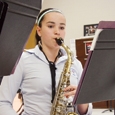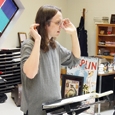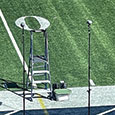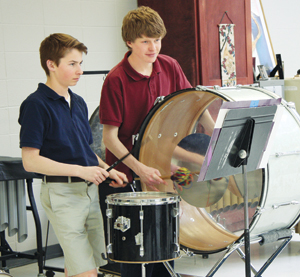 When Lloyd Potter decided to work with his band students at St. Thomas More High School on an original soundtrack for a silent movie, he did not realize just how rewarding the project would become. Over the months it took to complete the project and rehearse the music, Potter saw his group improve musically and grow closer as friends. The final performance was also a big hit with parents, administrators, and the community, and it received coverage from the three local television stations near Rapid City, South Dakota. Potter has subsequently tried the project again with his high school group and has even let his middle school band develop their own composition. His students discovered the joys and difficulties of creating music, not just reproducing it for a performance.
When Lloyd Potter decided to work with his band students at St. Thomas More High School on an original soundtrack for a silent movie, he did not realize just how rewarding the project would become. Over the months it took to complete the project and rehearse the music, Potter saw his group improve musically and grow closer as friends. The final performance was also a big hit with parents, administrators, and the community, and it received coverage from the three local television stations near Rapid City, South Dakota. Potter has subsequently tried the project again with his high school group and has even let his middle school band develop their own composition. His students discovered the joys and difficulties of creating music, not just reproducing it for a performance.
The composition project developed out of a belief that students should do more than prepare for the next concert. I talked with one of my former students, Altman Studeny, an artist-in-residence for the state of South Dakota. We developed an idea for him to work on a project with the band, advanced art class, and creative writing class. The classes were divided into three groups, and each researched local pioneer and Native American culture along with distinctive geographic features of the Black Hills. The band students each wrote a melody of 8 to 16 bars, the art class painted pictures, and the writing students wrote poems.
I took the six strongest musical samples and arranged them into minute-long pieces. The other teachers and I then found paintings and poems that worked well with the short arrangements. We performed these short works at a concert with the pictures projected on the band shell and students reading the relevant poems. The concert was a big success and made me think about the logical next step – a more elaborate composing project.
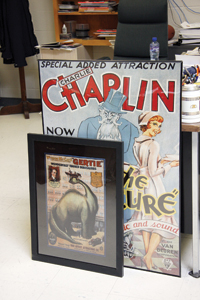 Scoring a Movie
Scoring a Movie
I thought about how cool it would be to write music to accompany a movie picture. I wanted to add a new dimension to a concert by requiring students to keep up with the movie while playing. I also thought it would be great to accompany a silent film because the soundtrack is so essential to conveying the mood and momentum of the picture. These older movies are generally in the public domain and have a long history of being shown with live musicians.
I found several Charlie Chaplin movies that were under 20 minutes and played them for students to get their reactions. The movies played without the sound because I did not want them to be influenced by someone else’s soundtrack ideas. It was strange watching without sound and a few students broken the silence by adding their own dialogue. Surprisingly, these students who grew up watching the Lord of the Rings movies enjoyed the slapstick comedy and action of the silent era. This enthusiasm spilled over into the work on the soundtrack.
Division of Labor
After picking a movie, I considered dividing it into different scenes and assigning each student to write for a different scene. I thought that might intimidate some with no previous writing experience. Instead, students were selected to write a particular style of music appropriate for various scenes: chases, dancing, scary moments, and humor. They had a month to watch at least ten movies with that style of music. For those watching movies with chase scenes, for example, they wrote down the key characteristics of that music – fast, slow, dissonant, and so forth. I instructed them to take notes that would help later in writing their own music.
When the month ended, we spent class time to write out their ideas, many of which were quite creative. Some of the students with limited experience with theory and composing had very interesting ideas on phrasing. Other students enjoyed composing so much that they wrote 50 measures or more. Most had some difficulty figuring out how to transfer the music they were playing on their instrument to paper. They devised crazy rhythms and needed help with notation.
Arranging the Fragments
Once the music was turned in, I put the melodies into Finale and added a bass line. I played the music samples with the bass line for the class, and they were astonished by the sound. Some doubted their abilities as composers but perked up when they heard this early version. Although I expected that putting the music with the movie would be the hardest part of the project, it actually took just a couple of weeks. I watched the movie repeatedly and tried different bits of music against various scenes to determine what worked best. I was amazed at how often the students’ music lined up well with a movie from decades ago.
I arranged the music as I went along, figuring out the melody for a section of the movie and then arranging that part for full band. When I did a similar project a year later, I decided on the music for the whole movie with just the piano and bass parts, and then wrote an arrangement for band. That approach worked faster.
One benefit of writing an arrangement for my group was understanding their strengths and weaknesses. I tried to give brass players some rest during the 20-minute movie, and the melody was spread around the band so no section spent the entire time playing half notes. However, if a flute player wrote a nice bit of melody, I would try to give that part to the flute section.
I quickly discovered the importance of keeping the music interesting but not too difficult. I tried to keep tempo changes to a minimum. I soon learned that quarter=120 is a tempo that everyone could play and is a great speed for action scenes. The hardest part of the entire project was for students to keep playing straight through while keeping up with the film. The task forced them to learn the music really well. One of the unexpected benefits of this project is that students now watch me much more closely because we had to make many, slight adjustments during the performance.
Putting on a Show
With the music arranged, I showed it to the students, who were impressed with the result. We then spent months learning to play it from top to bottom. I decided early on to memorize the score because my job required watching the movie instead of the score during the performance. I found over the months that by managing time well, the composing project did not take away from everything else I was trying to accomplish during the year. The process did test my patience at times.
The night of the concert was a big success. The fine arts club decorated the gym like an old time movie theater. We found replicas of silent movie posters and the art department made now playing signs. We sold popcorn and pop as concessions and this produced a nice atmosphere and was a good fundraiser. We brought the house lights down, and students watched the music with stand lights. I even conducted with a glow stick.
I was surprised before the concert to receive calls from all three local tv stations, which covered the event. I had no idea that they had even heard of our project. A local news anchor even attended in person. The parents could not believe how well the concert went and gave a standing ovation. We received glowing comments even from students who do not play in band but came to support their friends. We later put the movie up on our website to allow students to point out which parts they wrote to their parents. At the end of the project, we completed the copyright process with students. They now have their names on a copyrighted piece of music.
A Middle School Composition
I tried a shorter version of the composition project with the middle school this year because we had over two weeks after the Christmas concert before winter break. I gave them a weekend to go watch cartoons and a style of music to study. We spent a week in class teaching notation and how to figure out rhythms, and then used a couple of days to compose. Once again, I walked around offering guidance. It took me about
ten days to arrange the 3-1/2 minute piece.
I showed it to them the day before break, and they were very excited. Because of the difficulties in learning the music and keeping up with the movie, we have decided to play the movie with the finale score at an assembly. We are going to have three of the students talk about the experience and what they thought of it. The 6th graders were perhaps the most excited about the project. I don’t know if it is the age or that particular group.
In working with the younger group, I used the same basic approach to running the project with a shorter timeframe. I tried to be as encouraging as possible. A few of the students were shy and didn’t want to write the music because they didn’t think they had the skills. I remained patient and spent more time walking around and asking students to play what they had. There were some students who would hide their music whenever I would walk up to them. They tried to be stealthy and keep it from me until they turned it in. When I played the arranged music back for the first time, you could see students pop up with pride. They really enjoyed creating something new instead of just playing their instruments.
To see the finished projects, go to http://www.rccssonline.com/content/lloyd-potter-composerarranger
* * *
Student Opinions
As a senior at St. Thomas More High School, I have had the opportunity to take part in the composition of two original scores for silent film features. At first I though this was going to be an impossible task to write music for a 20-minute film, but soon our band’s creative juices were flowing. We were asked to watch ten movies to fit our genre of music, and it gradually became easier to conceive a feasible score. It was a moment of movie magic when we first saw the film with our score synched to it; the music seemed to fit flawlessly with the film Some apprehension existed as it was hard to stay perfectly in synch with the film, but Mr. Potter kept us on track with his conducting. The final product was a hit, so we decided to do it again this year with a shorter piece starring Gertie the Dinosaur.
The process was similar to the first year, but it was even harder to compose because we all wanted to match the excellence of last year’s success. Somehow, it all came together again, and the music seamlessly fit together to form the perfect background for Gertie and her antics. The process has been so amazing and has broadened the musical talents of the entire band. It has given me a new appreciation for music through the realization of how hard it is to compose music, especially when it must capture the essence and actions of a film where all the emotion depends on the music produced.
– Elise Twohy, Senior Alto Saxophone
Recently, our band director thought it would be fun to compose a soundtrack to a Charlie Chaplin movie. We were not thrilled at first, but I once we started writing the parts it was quite a bit of fun. I was the person to compose the main Charlie Chaplin theme, and it was a really great experience. I love Charlie Chaplin films a lot. This year we wrote the theme to a really old cartoon about a dinosaur named Gertie. We composed another score for it, and it turned out really well. For a really small band, we sound pretty good. I recently played in a band of over 100 people and then came home to play in our band. I was more impressed with our group than any other. In a small band like ours, you are friends with pretty much everyone.
– Clay Adams, Junior Tenor Sax
Our band teacher asked the class to write at least eight measures of music according to a specific mood (scary, happy, festive). We were not happy about doing this at first because it’s hard to organize music that sounds really good. We didn’t think it was going to sound good, but were surprised at the result when the pieces of our music were arranged together to be played with a silent Charlie Chaplin movie. When we did the assignment again the next year, we had an easier time whipping something together. Writing the music took a lot of effort, but it was really interesting to see everyone’s view on music and what they thought sounds good.
– Jessica Halvorson, Senior Clarinet
St. Thomas More High School is a private Catholic school in Rapid City, South Dakota. The school has about 250 students with about a quarter who perform in band, orchestra, and choir. Director Lloyd Potter notes that students are driven by academics at the school and often have busy schedules of AP classes that make participation in music difficult. The high school band meets daily during the school day and a jazz band meets three days at week for academic credit.
